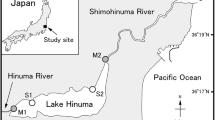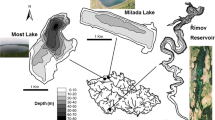Synopsis
Diel and spring/summer space-use and feeding patterns were investigated in an assemblage dominated by five fish species occupying the offshore waters of Lake Opinicon, a shallow mesotrophic lake in southeastern Ontario. We assessed fish distribution and diel movement in May and July through the use of gill nets set at various depths in 1.5–7.0 m depth contour zones, supplemented by observations of fish reaction to the nets. Golden shiners and alewives occupied the upper part of the water column, with the former concentrated at the littoral zone-open water interface, and the latter in the open water. Yellow perch occupied the lower part of the water column in all depth contours. Bluegills were abundant in the upper to midwater depths in all contour zones; black crappies were concentrated in the 2.5–3.5 m zones. All of these species showed either a diel or a spring-summer change in distribution pattern. Bluegills were more abundant in offshore locations in July, whereas golden shiners and yellow perch were more abundant onshore in May. Alewives and black crappies showed distinct diel movements in July, as they were largely absent from the study area during the day, but returned at night to feed. In general, there was more spatial separation among the five species in July than in May.
Patterns of spatial distribution among the species generally corresponded with the type and variety of prey consumed, and with diel movement of prey in the case of water column feeders. Other factors that apparently affected spatial distribution and seasonal shifts in this assemblage were risk of predation (golden shiner), spawning activity (alewife), and a decline in prey abundance from spring to summer (bluegill and yellow perch).
Similar content being viewed by others
References cited
Baker, J.A. & S.T. Ross. 1981. Spatial and temporal resource utilization by southeastern cyprinids. Copeia 1981: 178–189.
Bauman, P.C. & J.F. Kitchell. 1974. Diel patterns of distribution and feeding of bluegill (Lepomis macrochirus) in Lake Wingra, Wisconsin. Trans. Amer. Fish. Soc. 103: 255–260.
Brandt, S.B. 1980. Spatial segregations of adult and young-of-the-year alewives across a thermocline in Lake Michigan. Trans. Amer. Fish. Soc. 109: 469–478.
Brandt, S.B., D.M. Mason, D.B. Macneill, T. Coates & J.E. Gannon. 1987. Predation by alewives on larvae of perch in Lake Ontario. Trans. Amer. Fish. Soc. 116: 641–645.
Childers, W. & H.H. Schoemaker. 1953. Time of feeding the black crappie and the white crappie. Illinois Acad. Sci. Trans. 46: 227–230.
Curran, H.W., J. Bardach, R.I. Bowman & H.G. Lawler. 1947. A biological survey of Lake Opinicon progress report. Queen's University Biological Station, Chaffey's Lock. 48 pp.
Emery, A.R. 1973. Preliminary comparisons of day and night habits of freshwater fish in Ontario lakes. J. Fish. Res. Board Can. 30: 761–774.
Engel, S. & J.J. Magnuson. 1976. Vertical and horizontal distributions of coho salmon (Oncorhynchus kisutch), yellow perch (Perca flavescens), and cisco (Coregonus artedii) in Pallette Lake, Wisconsin J. Fish. Res. Board Can. 33: 2710–2715.
Gascon, D. & W.C. Leggett. 1977. Distribution, abundance and resource utilization of littoral zone fishes in response to a nutrient/production gradient in Lake Memphremagog. J. Fish. Res. Board Can. 34: 1105–1117.
Gibson, C.G.M. 1974. Seasonal abundance of Cladocera and Copepoda in Lake Opinicon. B.Sc. Thesis, Queen's University, Kingston. 34 pp.
Hall, D.J., E.E. Werner, J.F. Gilliam, G.G. Mittelbach, D. Howard & C.G. Doner. 1979. Diet foraging behaviour and prey selection in the golden shiner (Notemigonus crysoleucas). J. Fish. Res. Board Can. 36: 1029–1039.
Helfman, G.S. 1979. Twilight activities of yellow perch, Perca flavescens. J. Fish. Res. Board Can. 36: 173–179.
Hellman G.S. 1981. Twilight activities and temporal structure in a freshwater fish community. Can. J. Fish. Aquat. Sci. 38: 1405–1420.
Horak, D.L. & H.A. Tanner. 1964. The use of vertical gill nets in Horsetooth Reservoir, Colorado — in studying fish depth distribution. Trans. Amer. Fish. Soc. 93: 137–145.
Hilsenhoff, W.L. 1966. The biology of Chironomus plumosus in Lake Winnebago, Wisconsin. Ann. Entom. Soc. Amer. 59: 465–473.
Janssen, J. & S.B. Brandt. 1980. Feeding ecology and vertical migration of adult alewives (Alosa pseudoharengus) in Lake Michigan. Can. J. Fish. Aquat. Sci. 37: 177–184.
Keast, A. 1977. Diet overlaps and feeding relationships between the year classes in the yellow perch (Perca flavescens). Env. Biol. Fish. 2: 53–70.
Keast, A. 1978. Trophic and spatial interrelationships in the fish species of an Ontario temperate lake. Env. Biol. Fish. 3: 7–31.
Keast, A. 1984. The introduced aquatic macrophyte, Myriophyllum spicatum as habitat for fish and their invertebrate prey. Can. J. Zool. 62: 1289–1303.
Keast, A. 1985a. Planktivory in larval, juvenile, and adult planktivores: resource division in a small lake. Verb. Int. Verein. Limnol. 23: 1692–1697.
Keast, A. 1985b. The piscivore feeding guild of fishes in small freshwater ecosystems. Env. Biol. Fish. 12: 119–129.
Keast, A. 1985c. Development of dietary specializations in a summer community of juvenile fishes. Env. Biol. Fish. 13: 211–224.
Keast, A. & J. Harker. 1977. Fish distribution and benthic invertebrate biomass relative to depth in an Ontario lake. Env. Biol. Fish. 2: 235–240.
Keast, A., J. Harker & D. Turnbull. 1978. Nearshore fish habitat utilization and species associations in Lake Opinicon (Ontario, Canada). Env. Biol. Fish. 3: 173–184.
Mittelbach, G. 1986. Predator-mediated habitat use: some consequences for species interactions. Env. Biol. Fish. 16: 159–169.
Olson, R.A., J.D. Winter, D.C. Nettles & J.M. Hayner. 1988. Resource partitioning in summer by salmonids in South Central Lake Ontario. Trans. Amer. Fish Soc. 117: 552–559.
Sarker, A.L. 1977. Feeding ecology of the bluegill, Lepomis macrochirus, in two heated reservoirs of Texas. III. Time of day and patterns of feeding. Trans. Amer. Fish. Soc. 106: 596–601.
Schindler, D.W. 1969. Two useful devices for vertical plankton and water sampling. J. Fish. Res. Board Can. 26: 1948–1955.
Seaburg, K.G. & J.B. Moyle. 1964. Feeding habits, digestive rates, and growth of some Minnesota warm water fishes. Trans. Amer. Fish. Soc. 93: 269–285.
Sokal, R.R. & F.J. Rohlf. 1981. Biometry (2nd ed.). W.H. Freeman and Co., New York. 859 pp.
Stang, D.L. & W.A. Hubert. 1984. Spatial separation of fishes captured in passive gear in a turbid prairie lake. Env. Biol. Fish. 11: 309–314.
Wallace, R.K. 1981. An assessment of diet-overlap indices. Trans. Amer. Fish. Soc. 110: 72–76.
Werner, E.E., D.J. Hall, D.R. Laughlin, D.J. Wagner, L.A. Wilsmann & F.C. Funk. 1977. Habitat partitioning in a freshwater fish community. J. Fish. Res. Board Can. 34: 360–370.
Werner, E.E., G.G. Mittelbach & D.J. Hall. 1981. The role of foraging profitability and experience in habitat use by the bluegill sunfish. Ecology 62: 116–125.
Windell, J.T. 1966. Rates of digestion in the bluegill sunfish. Invest. Indiana Lakes and Streams 7: 185–214.
Windell, J.T. 1978. Rates of digestion in fishes, pp. 159–183. In: S.D. Gerking (ed.) Ecology of Freshwater Fish Production, Blackwell Scientific Publications, Oxford.
Zaret, T.M. & J.S. Suffern. 1976. Vertical migration in zooplankton as a predator avoidance mechanism. Limnol. Oceanog. 21: 804–813.
Author information
Authors and Affiliations
Rights and permissions
About this article
Cite this article
Keast, A., Fox, M.G. Space use and feeding patterns of an offshore fish assemblage in a shallow mesotrophic lake. Environ Biol Fish 34, 159–170 (1992). https://doi.org/10.1007/BF00002391
Received:
Accepted:
Issue Date:
DOI: https://doi.org/10.1007/BF00002391




